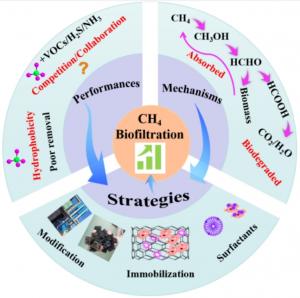Clearing the air: microbial biofilters offer low-cost methane mitigation
FAYETTEVILLE, GA, UNITED STATES, May 12, 2025 /EINPresswire.com/ -- Methane, a greenhouse gas over 25 times more potent than carbon dioxide, continues to seep into the atmosphere from landfills, fossil fuel operations, and agricultural sources. Tackling these diffuse emissions has been a persistent challenge—until now. A new scientific review highlights biofiltration, a nature-based solution that enlists methane-eating microbes, as a promising tool for mitigating this invisible threat. The review offers a deep dive into the biological and engineering principles behind biofiltration, evaluates its real-world effectiveness, and outlines targeted strategies to enhance system performance. From microbial metabolism to pollutant synergy, this study builds a scientific roadmap for integrating methane biofilters into broader climate action.
Methane’s role as a climate driver has become increasingly clear, particularly in sectors like waste management and fossil energy. While high-concentration methane can be burned for energy recovery, low-level emissions from industrial vents or agricultural sources often escape treatment due to high costs or inefficient technologies. Conventional combustion-based methods can also produce secondary carbon dioxide (CO₂) emissions. In this context, biofiltration—a technique that harnesses the metabolic power of microbes to oxidize methane—has gained attention as a sustainable alternative. Yet, the success of these systems depends on many variables, from gas composition to microbial ecosystem resilience. Due to these challenges, refining biofiltration strategies remains a critical area for research.
A team of researchers from Guangdong University of Petrochemical Technology, Hunan University, and Gdansk University of Technology published their findings (DOI: 10.1007/s11783-025-1987-6) on March 17, 2025, in Frontiers of Environmental Science & Engineering. Their review provides an in-depth synthesis of current technologies and offers actionable insights into optimizing biofilter systems for industrial methane mitigation.
The review breaks down methane removal into two key stages: first, the gas diffuses into the moist biofilm lining the filter, and second, specialized bacteria known as methanotrophs convert methane into carbon dioxide and biomass using enzymes such as methane monooxygenase. The study identifies crucial variables—such as filter configuration, microbial inoculum, and empty bed residence time (EBRT)—that influence removal efficiency, which can range from 20% to 95%. The authors also examine performance under complex gas mixtures. In particular, volatile organic compounds (VOCs) like styrene and xylene can inhibit methane degradation by competing for microbial enzymes, while methane often exerts a neutral or beneficial effect on VOC removal. The use of fungi can enhance mass transfer but may increase clogging risk. To overcome such challenges, the review proposes three enhancement strategies: stimulating microbial activity, engineering the physical structure of packing media, and adding surfactants to improve gas–liquid interactions.
“Biofiltration represents a scalable, low-energy alternative to traditional methane treatment technologies,” said corresponding author Dr. Chunping Yang. “But its success depends on a nuanced understanding of microbial interactions and system design. This review bridges the gap between theory and application, offering practical guidance for advancing biofiltration in real-world contexts.”
With global initiatives such as the Global Methane Pledge spotlighting the urgency of methane reduction, this research arrives at a pivotal moment. Biofiltration systems not only provide a cost-effective route to cutting emissions but also reflect circular economy values by converting waste gas into useful biomass. By consolidating the latest findings on system dynamics, microbial mechanisms, and engineering interventions, this review paves the way for the next generation of methane mitigation tools—designed for impact, built for resilience.
References
DOI
10.1007/s11783-025-1987-6
Original Source URL
https://doi.org/10.1007/s11783-025-1987-6
Funding Information
This work was supported by the Department of Science and Technology of Guangdong Province of China (No. 2024A1515010837), the National Natural Science Foundation of China (Nos. 52200093, 52270064, 51978178, and 51521006), the Program for Innovative Research Teams of Guangdong Higher Education Institutes of China (No. 2021KCXTD043), the Science and Technology Innovation Program of Hunan Province of China (No. 2023RC3120), the Startup Fund of Guangdong University of Petrochemical Technology (China) (No. 2018rc63), and the Postgraduate Scientific Research Innovation Project of Hunan Province (China) (No. QL20230078).
Lucy Wang
BioDesign Research
email us here
Legal Disclaimer:
EIN Presswire provides this news content "as is" without warranty of any kind. We do not accept any responsibility or liability for the accuracy, content, images, videos, licenses, completeness, legality, or reliability of the information contained in this article. If you have any complaints or copyright issues related to this article, kindly contact the author above.
Shriners Children’s St. Louis Utilizing New Scoliosis Treatment to Help Patients Recover Faster
'A Chance to Trance' Hypnosis Event Comes to Bellevue – June 28
Los Angeles Tribune Global Magicians Hall of Fame Announces Full Lineup of Honorees, Performers, and Presenters
Kalendarium
Więcej ważnych informacji
 Jedynka Newserii
Jedynka Newserii

 Jedynka Newserii
Jedynka Newserii

Prawo

Przedsiębiorcy chcą uproszczenia kontroli celno-skarbowych i podatkowych. Wskazują na potrzebę dialogu z kontrolerami
Poprawa relacji z fiskusem i urzędnikami przeprowadzającymi kontrole to jeden z najczęściej podnoszonych postulatów przez przedsiębiorców. W ramach deregulacji prowadzonej przez rząd domagają się oni większej współpracy i otwartości na wyjaśnienia ze strony organów podatkowych, jasnej interpretacji przepisów, partnerskiego traktowania oraz skrócenia procesu przedawnienia. Te zmiany mogłyby poprawić atmosferę i klimat dyskusji między przedsiębiorcami a rządem.
Bankowość
Banki zainteresowane projektami gospodarki obiegu zamkniętego. Chętniej finansują takie inwestycje

Rynek zrównoważonego finansowania rośnie. Banki stawiają na rozwój oferty zielonych instrumentów, które przedsiębiorcy i inne instytucje mogą przeznaczyć na sfinansowanie inwestycji z różnych obszarów ESG. Są wśród nich zarówno zielone obligacje, jak i kredyty połączone z realizacją konkretnych celów klimatycznych. Jednym z obszarów, które chcą finansować firmy w ramach ESG, jest gospodarka obiegu zamkniętego, czyli zamykanie obiegu produktów w myśl zasady reduce, reuse i recycle (ogranicz, użyj ponownie, przetwórz).
Handel
E-papierosy i aromatyzowane saszetki nikotynowe mogą zniknąć z rynku. Ministerstwo Zdrowia chce całkowitego zakazu ich sprzedaży

W wykazie prac legislacyjnych pojawiła się nowa propozycja Ministerstwa Zdrowia, która przewiduje zakaz wprowadzania do obrotu papierosów elektronicznych jednorazowego użytku – zarówno tych z nikotyną, jak i bez niej, oraz zakaz stosowania aromatów w woreczkach nikotynowych. Projekt trafił do konsultacji społecznych. To już kolejna regulacja sektora tytoniowego w ostatnich miesiącach. Przedstawiciele biznesu podkreślają, że to chaos regulacyjny, który wpływa na brak poczucia pewności prawnej i decyzje inwestycyjne.
Partner serwisu
Szkolenia

Akademia Newserii
Akademia Newserii to projekt, w ramach którego najlepsi polscy dziennikarze biznesowi, giełdowi oraz lifestylowi, a także szkoleniowcy z wieloletnim doświadczeniem dzielą się swoją wiedzą nt. pracy z mediami.









.gif)

 |
| |
| |
|